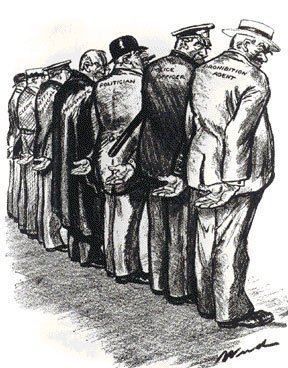Do Un-Evolved Alcohol Laws Justify Lawbreaking?
 I spent a good two and a half hours yesterday speaking to a nice sized collection of wine industry members about the Three-Tier System on the newish social media platform Clubhouse. In the Clubhouse room “The Business of Booze”, created and moderated by Bulgarian wine importer Robert Hayk of G & B Importers, upwards of 70 or so producers, importers, communicators, retailers and media undertook an examination of the predominant system of alcohol regulation in the United States. It was a fascinating 150 minutes.
I spent a good two and a half hours yesterday speaking to a nice sized collection of wine industry members about the Three-Tier System on the newish social media platform Clubhouse. In the Clubhouse room “The Business of Booze”, created and moderated by Bulgarian wine importer Robert Hayk of G & B Importers, upwards of 70 or so producers, importers, communicators, retailers and media undertook an examination of the predominant system of alcohol regulation in the United States. It was a fascinating 150 minutes.
While most attendees understood that the three-tier system emerged as a regulatory scheme in the wake of the repeal of Prohibition, not many folks know how and why it formed. Here’s the story, with a punchline at the end.
When Prohibition was clearly nearing its end in the early 1930s as huge swaths of the United States population realized the crime created by Prohibition was too great a threat to the country, John D. Rockefeller, a former proponent of Prohibition, decided that it was critical to ready a new regulatory structure for alcohol when Repeal arrived.
To that end, Rockefeller created a commission of sorts to develop a potential alcohol regulatory scheme. His most pressing concern was to rid the alcohol industry of the criminal element while promoting temperance was a second but true lesser goal. He turned to Raymond Fosdick, an associate of Rockefeller’s and a season public administrator, to do a study of various liquor control systems and come up with regulatory recommendations for states to consider after Repeal arrived.
concern was to rid the alcohol industry of the criminal element while promoting temperance was a second but true lesser goal. He turned to Raymond Fosdick, an associate of Rockefeller’s and a season public administrator, to do a study of various liquor control systems and come up with regulatory recommendations for states to consider after Repeal arrived.
The report that Fosdick wrote and that was endorsed by Rockefeller and released with great fanfare in October 1933—two months before the 21st Amendment ending Prohibition was ratified—laid out two options for regulating alcohol.
1-State Control: Whereby the state would control the distribution and sale of alcohol, presumably taking the profit motive out of the equation.
2-Licensure System: Whereby states would issue licenses to producers, wholesalers and retailers, which in turn could not hold licenses in more than one of the tiers.
The greatest achievement of the report, Toward Liquor Control, was that it put the nail in the coffin of the Saloon Culture that existed prior to Prohibition. Across the United States and primarily in metropolitan areas, Saloons were the center of social life for many men. These Saloons were often “Tied” to producers through either ownership or partnership arrangements whereby one brand of beer or spirits was sold exclusively. The marketing practices of the saloons were disastrous. Often free lunches and dinners were given with the purchase of pitchers of beer or multiple shots of alcohol. These were the places where many men and particularly immigrants spent a great deal of time, drank way too much, and that too often resulted in individuals and families falling into disrepair.
Toward Liquor Control’s Licensure System resulted in states liberally granting licenses for on-premise and off-premise liquor dispensaries which in turn resulted in the Saloon being buried through a diversity of venues offering alcohol.
Fosdick however did not favor his licensure system. Rather, he believed that state control over the sale and distribution of alcohol would be the more effective means of controlling the criminal element that he believed had come to define the Prohibition era.
 Fosdick also believed that the Licensure system would lead to political battles between licensees. In Toward Liquor Control Fosdick wrote:
Fosdick also believed that the Licensure system would lead to political battles between licensees. In Toward Liquor Control Fosdick wrote:
“Every licensee, as well as every manufacturer who sells to a licensee or has any interest in the business, begins to marshal his own political strength to serve his own ends. A multitude of private traders means a multitude of opportunities for political favoritism.”
This observation was prescient. Today, almost 90 years after the publication of Toward Liquor Control, we have an alcohol regulatory system that is based almost entirely on political favoritism in which the most powerful elements of the system—the state-protected middle tier—uses its subsidized spot in the three-tier system to control the regulatory system and skew it in its favor.
Today, Toward Liquor Control is idolized by wholesalers nearly as much as the three-tier system is idolized and protected by the middle tier. They see it as one of the most successful regulatory innovations in the history of the United States. They also see it as the blueprint for the three-tier system that requires producers to sell their products through wholesalers in order to bring their products to market. It’s not surprising that when discussing the three-tier system or the influence of Toward Liquor Control that wholesalers and their compatriots in the government protection racket—the alcohol regulatory community—don’t mention Fosdick’s observation that the licensure system will lead to political corruption.
But there is one other observation in Toward Liquor Control that wholesalers, regulators and other defenders of the three-tier system never reference. Near the end of the book, Fosdick makes an important, even fundamental point about alcohol regulation that is more true today than it was in the 1930s:
“We need to be on our guard against any system of control that has outlived its usefulness and that no longer represents the prevalent ideas and attitudes of the community. In the last analysis, there is but one fundamental rule to be followed – and all other rules are corollaries: If the new system is not rooted in what the people of each state sincerely desire at this moment, it makes no difference how logical and complete it may appear as a statute – it cannot succeed.”
Here Fosdick says that the critical element of any alcohol regulatory system is that it evolves to match the desires of the people that interact with it: consumers. And he’s right. Without a system that matches the desires of the populous, you will have lawlessness and disdain for the system And this is exactly what we have today.
The system of alcohol regulation in place in most states today ignores the proliferation of producers of beer, wine, and spirits that cannot successfully bring their products to market due primarily to the state laws that require alcohol to be sold via wholesalers. Because the required use of wholesalers remains a primary element of alcohol regulation, wholesalers are able to charge outrageous fees for their services (where else are producers supposed to go to bring their products to market). Moreover, no consumers respect or support this system once its protectionist and discriminatory foundations are explained to them.
The vast majority of alcohol regulatory systems in the 50 states bar the consumer from using e-commerce to purchase and have delivered to them wines from out-of-state retailers, a circumstance that completely ignores the modern digital economy and for no other reason than protection from competition is desired by wholesalers and often retailers that don’t want to see consumers able to purchase alcohol from anyone but them, and certainly not from out-of-state sources.
So, is it any wonder that Consumers, producers and retailers have been known to ignore the rules when it comes to practices like direct shipment of products. Is it any wonder that consumers who can’t find the wine, beer or spirit they want in local outlets are more than happy to ignore the ancient, unevolved rules attached to corrupt and sclerotic regulatory systems and simply break the law to obtain what they want? Of course, it’s not surprising. And consumers will continue to ignore laws that seek to bar them from obtaining perfectly safe products that can’t be obtained locally.
direct shipment of products. Is it any wonder that consumers who can’t find the wine, beer or spirit they want in local outlets are more than happy to ignore the ancient, unevolved rules attached to corrupt and sclerotic regulatory systems and simply break the law to obtain what they want? Of course, it’s not surprising. And consumers will continue to ignore laws that seek to bar them from obtaining perfectly safe products that can’t be obtained locally.
Nor is it surprising that consumers always support proposals that give them more access to products.
It was not surprising either that in yesterday’s Clubhouse event every single person who spoke perfectly understood the vast limitations of the three-tier system to serve the marketplace. The normal response to this understanding is to find ways around the old system; to bend the rules; to stretch the system’s archaic structure to accommodate a modern economy, the modern consumer and the modern marketplace that appear to have gone unnoticed by lawmakers and alcohol regulators.
There is a substantial desire within the American alcohol industry for structural change and reform. The community, group or organization that can harness that desire could bring substantial and truly positive change to the American alcohol marketplace…if only the corruption inherent in the three-tier system and among its most ardent supporters within the middle tier and within government can be overcome.

Thanks, Tom, for the deep dive on this corrupt system that still has a stranglehold on the small family winery-retail industry.
When I tell other lawyers about the three tier system and the 21st amendment system, their jaws drop. It flies in the face of all of the otherwise progressive open sales laws we have in the country. Fight the good fight, Tom, to knock these archaic laws down.
Excellent Tom. Interesting the Saloon Culture.
Damn, I miss the free lunches.
Full disclosure: I am a small, licensed importer/wholesaler. I generally have no issue with the article but feel that there are a few important things missing. Simply abolishing the 3 tier system would improve range of availability, but there are other issues mainly state by state that would need to be addressed in order for delivered price to consumer to make sense.
If the 3-tier system were abolished, I would immediately set up a retail operation and a consumer shipping operation/wine club, and anything I didn’t sell to consumers I would wholesale wherever else I can. So from my standpoint, this is not an existential issue.
The question is, without wholesalers, how do small family producers and retailers take advantage of economies of scale? Are retailers going to order full pallets, which is usually the minimum a winery requires and the minimum that makes sense for trucking or ocean shipping? Or will you air-ship cases and individual bottles at costs that equal the value of the wine? Do retailers want to get in the business of warehousing and managing logistics, excise tax, etc. to order quantities that make sense? (if they do, be my guest)
How do you tackle state to state restrictions? In some states retailers can’t even ship within their own state, let alone others. Wholesalers have to navigate state by state requirements. It’s a lot easier for any entity–retailer, wholesaler, producer–to get economies of scale when your available market is that much bigger.
And this gets into practicality. How do you get 50 states to shutter the system? How does this help me or anyone else navigate the 50 different sets of rules we need to play by?
In general it is correct that the system limits availability to consumers and also prohibits producers from getting to market. Honestly there are so many good wines out there looking for homes. More could be brought to market if the market could bear it. And in order for the market to bear it, the very real issue of economies of scale needs to be part of that solution, not simply railing against the middle tier.
There’s a bit of mythology behind the Rockefeller Commission and Fosdick and Scott drawing their own conclusions on solving the “liquor problem”. Virtually all of their recommendations were taken from identical policy recommendations that were made 30 years earlier by The Committee of Fifty. (hat tip to Harry Levine who has published papers on this topic)
It’s also worth noting that Toward Liquor Control itself makes an argument in favor of shipping to consumers on page 56. The discussion was related to shipping into dry areas but it the principle applies to all DtC shipping…..if you don’t create a legal framework, “the boolegger is always there even if the liquor shop is not.”